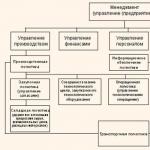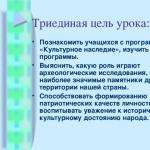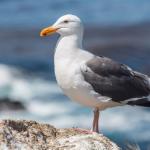Bird species by habitat. Ecological groups of birds by habitat. What we learned
The vast class of Birds is represented by thousands of species that have adapted to different environmental conditions. Birds have mastered forests, meadows, mountains, swamps, learned to build complex nests and obtain various foods. Depending on their place of residence and behavior, ecological groups of birds are distinguished.
By location
Birds belonging to different families and species have developed similar characteristics under the influence of the environment. The table describes the characteristics of ecological groups by habitat.

Rice. 1. Water-air birds.
Table “Ecological groups of birds”
|
Group |
Description |
Morphology |
Nutrition |
|
Forest - owl, woodpecker, wood grouse, thrush, cuckoo |
Birds of prey, insectivores, herbivores, omnivores. They live in all layers of the forest - on trees, shrubs, and grasses |
Small body size; Short wide wings; A long tail; Short sharp beak; Tenacious paws |
Seeds, berries, nuts, cones, caterpillars, small rodents, lizards |
|
Open air spaces - swallow, swift, flycatcher |
Active in the air. They feed on the fly. They nest in forests, parks, and cities |
Small body; Short legs; Developed pectoral muscles; Elongated wings and tail; Small, wide-opening beak |
Insects |
|
Waterfowl - ducks, swans, geese |
Feeding and nesting are associated with fresh water bodies - rivers, lakes, ponds. They nest on land. Good diving and swimming |
Wide body with tight-fitting plumage; Widely spaced legs; Webbed feet; Abundant fluff; Thick subcutaneous fat; The coccygeal glands abundantly secrete a water-repellent secretion; Flat beak with filtering apparatus (transverse plates) |
Worms, mollusks, algae, crustaceans |
|
Aquatic - terns, gulls, cormorants, grebes, pelicans, albatross |
Associated with water, but spend most of their life in the air. They fly well. They can surf the waves, but swim poorly. Diving from the air |
Wide wingspan; Dense streamlined body; Short or missing membranes; Powerful elongated beak, sometimes curved down |
Fish, crustaceans, crabs, shellfish |
|
Steppe and desert - ostriches, demoiselle crane, bustard |
Flying and flightless birds. They run fast and have excellent eyesight and hearing. Flying birds cover long distances. They nest on the ground in primitive nests. Some species are scavengers and predators |
Camouflage painting; Strong long legs; Elongated neck; Powerful beak |
Omnivores |
|
Swamp and coastal birds - stork, heron, sandpiper, flamingo |
They feed in wetlands. They fly well. They nest on land. |
The body is dense, displaced downwards; Long, unwebbed legs; Elongated sharp beak or filter beak; High neck |
Amphibians, crustaceans, fish |
|
Meadow and wildflowers - lapwing, wagtail, corncrake, quail, wood lark, skylark, hawk, meadow harrier |
Small or medium birds. They nest on the ground. There are birds of prey with a curved beak, excellent vision, and fast flight. |
Small head; Large elongated body; Short and wide wings; Elongated and short beak; Camouflage painting |
Insects, lizards, small rodents, seeds, berries |

Rice. 2. Crake.
Penguins are active underwater and form a separate group of divers. They have an elongated body with a downward center of gravity and a sharp beak. They can't fly. They feed on fish.
By nesting site
There are five groups:
- crown-nested - on trees (oriole);
- shrubby - on bushes (robins);
- ground - on the ground (oatmeal);
- hollow-nesting - in hollows (pika);
- burrowers - underground (shore swallows).

Rice. 3. Nests of shore swallows.
Some species (guillemot, nightjar, owl) lay eggs on bare rocks or in hollows without building nests.
What have we learned?
From the 7th grade biology article, we learned about the main ecological groups based on habitat and nesting areas. Groups of birds, depending on their living conditions, have similar characteristics that help them survive (camouflage in grass, water-repellent lubricant in water, excellent vision in open spaces).
Test on the topic
Evaluation of the report
Average rating: 4.4. Total ratings received: 113.
Birds are adapted to different habitats, which determines the emergence of ecological groups among them (Table 1).
Each group is attached to its habitats, uses its own food and has certain adaptations for obtaining it.
Table 1.
Ecological groups of birds
| Habitats | Representatives | Features of the environmental group |
| Birds of the forest | Tit, pika, nuthatch | Small legs, medium sized head. No neck. The eyes are on the sides. Thin beak. Tenacious and sharp claws, long fingers. Stiff tail feathers. Migratory and nomadic |
| Woodpeckers | Chisel-shaped beak. Long, thin and hard tongue. Tenacious fingers (two forward, two back). The tail feathers are hard and elastic. They feed on insect larvae and, in winter, on the seeds of coniferous plants. Sedentary and nomadic | |
| Hazel grouse, black grouse, capercaillie, partridge | They spend a lot of time on the ground. Strong legs armed with large claws that help rake forest floors. A strong, downward-curved beak helps to bite through fruits and plant shoots. The wings are short and wide. Sedentary | |
| Crossbill | The beak is designed to remove seeds from the cones of coniferous trees. Sedentary | |
| Birds of open air spaces | Swallow, swift, nightjar | Long and narrow wings, a tail with a notch - a rudder during flight. The beak is small, with a large oral funnel of bristle-like feathers at the corners of the mouth. The legs are short, tightly pressed to the body during flight. They feed on insects in the air. They have very strong wings and very light bones as an adaptation to migration. Migratory. |
| Birds of steppes and deserts | Bustard, ostrich, little bustard, crane | Omnivores. They nest on the ground. The coccygeal gland is poorly developed. Long legs, neck and beak. Migratory |
| Birds of open areas of reservoirs | Ducks, geese, swans, grebes | They swim well, many dive. The body is flattened, the legs are moved far back, with webbed toes. The plumage is dense, the coccygeal gland is well developed. The beak is flattened, with horny teeth along the edges. Migratory |
| Birds of coasts, reservoirs and swamps | Heron, stork, waders, flamingo | Thin, webbed legs. Long neck and beak, which is laterally compressed. Feeding on aquatic animals. They nest on the shore or rarely in trees. Migratory |
| Birds of ponds | Seagull, guillemot, cutwater, puffin, cormorant | They feed on fish. Powerful beak for catching fish from the air and underwater. Sedentary. They form colonies. |
| Predator birds | Eagle, falcons, vulture, hawk, kite, owl | Excellent eyesight, powerful wings, sharp curved claws and a hooked beak. Many birds of prey can soar in air currents for a long time. Sedentary |
Meaning in nature
Birds destroy insects and mouse-like rodents (gophers, voles, hamsters, rats, etc.). Some birds contribute to the spread of plants (the restoration of Siberian pine is associated with nutcrackers feeding on pine nuts; jays contribute to the spread of oak trees; waxwings, thrushes, hazel grouse, etc. carry the seeds of many plants).
The role of birds in food chains is great, since they represent the final links of many food chains. Birds are of great importance in the distribution of fruits and seeds.
Meaning in human life
Positive
In human economic activity, the importance of birds is mainly positive: they exterminate rodents, insect pests, and weed seeds, which can be considered as biological protection of fields and gardens.
Birds carry infectious diseases: influenza, encephalitis, salmonellosis, spread ticks, fleas.
A person is engaged in poultry farming, raising poultry, as well as ornamental and songbirds. Many species of wild birds serve as objects of sport and commercial hunting.
Domesticated birds (chickens, ducks, turkeys, guinea fowl) have long been used to produce meat, eggs, down, feathers and other valuable products and industrial raw materials.
Negative
Few species of birds can also cause some damage: they peck at fruits, pecking out plant seeds in search of insects.
Birds can spread pathogens. The role of birds in the circulation of a number of viral diseases has been established: ornithosis, influenza, encephalitis, etc.
80 species of birds are listed in the Red Book.
3.4.8. Class Mammals(Mammalia)
The highest class of terrestrial vertebrates. Currently, about 5,500 modern species of mammals are known, among which is the species Homo sapiens sapiens. The total number of mammal species, including extinct ones, exceeds 20,000 species.
Mammals appeared at the very end of the Permian period of the Paleozoic era (230 million years ago), originating from ancient primitive Paleozoic reptiles. Placental mammals already existed in the Cretaceous period of the Mesozoic era (no earlier than 136 million years ago and no later than 66 million years ago).
According to modern ideas, mammals evolved from Synapsid from the group Tsinodontov, emerging at the end of the Triassic (Oligokyphus, one of the supposed representatives, lived in the Late Triassic and Early Jurassic) (Fig. 3.172).
Rice. 3.172. Oligokyphus
General characteristics of the class
1) Live birth (except for representatives of the subclass Primal beasts, which produce young from eggs)
2) Warm-blooded (exception – rodent Naked mole rat) (Fig. 3.172)

Rice. 3.172. Naked mole rat
3) The appearance of wool, the development of sweat and sebaceous glands.
4) Division of the spine into 5 sections (cervical, thoracic, lumbar, sacral, caudal).
5) The presence of the diaphragm, subcutaneous muscles.
6) A high level of development of the nervous system, which provides a flexible response to influences from the external environment.
7) Strong development of the forebrain, the transition to it of the functions of the main visual center and the control center for complex forms of behavior.
8) The external ear canal and the auricle, in the middle ear there are 3 auditory ossicles.
9) Alveolar structure of the lungs;
10) Complete separation of the blood circulation, the presence of a 4-chambered heart and one (left) aortic arch;
11) Nuclear-free red blood cells.
12) Differentiation of teeth into incisors, canines, molars, sitting in the cells (alveoli) of the jaws.
Aromorphoses of mammals
Feeding the baby with milk;
Progressive development of the nervous system - the cerebral cortex (the center of higher nervous activity);
Development of the fetus in the mother's body, live birth;
Complete separation of circulatory circles, 4-chambered heart, left aortic arch, anucleated red blood cells;
Hairline;
Alveolar lungs;
Perfect thermoregulation;
Differentiation of the dental system;
Placement of limbs under the body;
Complication of the structure of the sense organs.
Birds are the largest class of terrestrial vertebrates. It contains about 9,000 modern species. They are grouped into three large groups: penguins, ostriches and typical birds.
Systematic groups of birds
Ostriches comprise the largest modern birds (Fig. 176), living in the open landscapes of Africa, South America and Australia. These birds cannot fly, since their wings are reduced, the contour feathers are spread out: they do not have hooks and the beards do not form closed fans. The small sternum lacks a keel. Representatives of ostriches are excellent runners, reaching speeds of up to 70 km/h. The small head of ostriches is raised high on an elongated neck, which allows them to inspect their surroundings from a great distance. They feed on seeds, insects, and small vertebrates. This group includes African ostriches, American rheas, Australian emus, cassowaries, kiwis and others, a total of 50 modern species.
Rice. 176. African ostrich
The African ostrich is the largest modern bird, up to 3 m high and weighing about 90 kg. The legs are two-toed. The male makes a nest on the ground in a hole. Then several females lay seven to eight eggs in it. There are up to 50 eggs in the nest, each weighing about 1.5 kg. The eggs are incubated: the male incubates at night, and the females alternate during the day for 6-7 weeks. There are two species of rhea in South America, and emus and cassowaries in Australia. They are smaller than the African ostrich and have three toes. The smallest of the ostrich birds, the kiwi, weighing 2-3 kg, lives in New Zealand. Due to deforestation and cutting down of bushes, the number of kiwis has sharply decreased. The kiwi is now the national emblem of New Zealand. This bird has been taken into custody. Ostriches are bred on farms, and they produce meat, eggs, and feathers.
Penguins include 17 species. In appearance and structural features, penguins are very unique (Fig. 177). Their entire body is evenly covered with feathers. Rigid feathers with widened flattened shafts and small webs fit tightly, tiled-like over each other. The forelimbs are modified into flipper wings, the legs are moved back. On land, penguins move in an upright position. This is facilitated by the short tail on which the birds rely.

Rice. 177. Penguins: 1 - imperial; 2 - Adele; 3 - golden-haired; 4 - Antarctic
Penguins feed in the sea, catching small fish, mollusks, crustaceans, excellent swimming and diving. The main organs of movement in the water are the wings-flippers, and the legs, which have membranes, act as rudders. They spend a lot of time in the water, even the body color of penguins is similar to aquatic inhabitants: the lower side is light, the upper side is dark. In water they can reach speeds of up to 30 km/h. Distributed only in the Southern Hemisphere: from the tropics to Antarctica.
The largest in the superorder is the emperor penguin, about 120 cm high and weighing about 45 kg. It nests on the ice off the coast of Antarctica. When incubating, a single egg is placed on the paws and covered with a fold of skin on top.
Typical birds include most living bird species. These are mainly flying birds, so they have well-defined adaptations for flight. The features of their structure and biology are described in the general characteristics of the class of birds. They are distributed throughout the globe. In Russia there are representatives of 18 systematic groups (falcons, Anseriformes, owls, woodpeckers, passerines, etc.) - a total of 720 species (Fig. 178). They belong to different ecological groups.

Rice. 178. Various birds: 1 - finch; 2 - great tit; 3 - great spotted woodpecker; 4 - common pika; 5 - gray heron; 6 - bustard; 7 - common nuthatch; 8 - skylark; 9 - mallard; 10 - oystercatcher
Ecological groups of birds
Distribution of birds by ecological groups. Ecological groups by habitat (Fig. 179) include birds that have the most characteristic adaptations (adaptations) to life in certain conditions: in the forest, in open spaces, reservoirs, their coasts, swamps. In this case, not only the structure, but also the behavior is taken into account.

Cassock. 179. Representatives of different ecological groups of birds, identified by habitat: 1 - black swift; 2 - black-headed gull; 3 - gray owl
Often, ecological groups of birds are determined by their nesting sites: crown-nesting, bush-nesting, ground-nesting, cavity-nesting, burrowing.
Ecological groups of birds are also distinguished by type of diet: herbivores (including granivores), insectivores, carnivores, omnivores, carrion eaters. There is a peculiar group of birds that forage in the air. It includes swallows and swifts (Fig. 179, 1 and 180). They spend almost their entire lives in the air, hunting for insects from morning to evening. They have long sickle-shaped wings. The beak is small, and the mouth opening is huge, the corners of the mouth go behind the eyes. With their mouths wide open, they catch flying insects, while the size of the oral funnel is increased by the bristles located at the corners of the mouth. In good dry weather, insects rise high above the ground, and when air humidity rises, the wings of insects get wet and they fly low above the ground. Swallows and swifts follow them, so the approach of rain is predicted by the flight altitude of swallows and swifts.

Rice. 180. Swallows: 1 - killer whale; 2 - urban; 3 - coastal
Birds from different, sometimes distant from each other, systematic groups often fall into the same ecological group, since taxonomy is built on the basis of genetic proximity, degree of relationship, and common origin. Thus, the ecological group of birds of prey includes owls (Fig. 179, 3), daytime predators (Fig. 181 and 183) and even shrikes, which are classified as songbirds. They all have common characteristics of predators. They have large, strong legs armed with sharp claws and a hook-shaped beak.

Rice. 181. Eagle golden eagle
Depending on the nature of food, birds have differently developed beaks and limbs. Thus, insectivorous tits, pikas, kinglets, and warblers have thin, pointed beaks that allow them to get insects from crevices in the bark, grab them from leaves, and remove them from the scales of cones. Sharp claws and long fingers allow these birds to stay on branches.
Everyone is familiar with the bright Great Spotted Woodpecker. It has a strong chisel-shaped beak. The woodpecker uses it to crush wood damaged by insect larvae, finds the larvae, threads them onto the tip of a long, thin, hard tongue and eats them. In winter, the woodpecker feeds on the seeds of coniferous plants. Places the cone into a crevice in the trunk, the so-called “forge”, breaks the scales with precise blows and takes out the seeds. Having processed the cone in this way, the woodpecker brings a new one.

Rice. 182. Forest granivorous and insectivorous birds: 1 - common grosbeak; 2 - spruce crossbill; 3 - yellow-headed kinglet; 4 - pied flycatcher; 5 - willow warbler
When chiseling wood and processing cones, the woodpecker holds firmly to the bark. He has long thin fingers armed with sharp claws, two fingers pointing forward, two back. Sitting on a tree trunk, a woodpecker leans on it with its hard, elastic tail feathers.
Herbivorous birds - greenfinches, bee-eaters, grosbeaks, crossbills. They have a powerful beak, which is used to split the dense shells of fruits. This is how the grosbeak successfully breaks apart the strong fruits of bird cherry and cherry. The sharp ends of the crossing beak of crossbills allow them to deftly extract seeds from pine and spruce cones.
Large forest birds - hazel grouse, black grouse, wood grouse - spend a lot of time on the ground. With strong legs armed with large claws, they rake the forest floor, collect seeds of plants, insects, and earthworms. With strong beaks they bite buds, young shoots of trees and shrubs, and feed on juicy blueberries, blueberries, and lingonberries. The magpie and goshawk have a typical appearance for forest birds (Fig. 183): relatively short, rounded wings and a long tail. These birds maneuver beautifully among forest trees and have nimble flight. However, due to the use of different foods, their legs and beaks are developed differently. The hawk is a predator: various small birds serve as its prey. With strong legs armed with powerful claws, the hawk grabs its prey and dismembers it with its curved predatory beak. The magpie has a small cone-shaped beak, which helps it eat a variety of foods (be an omnivore): collect fruits and seeds from the ground, grab insects, worms, and even catch a small mouse.

Rice. 183. Goshawk
Birds of open spaces live in meadows, steppes, and deserts. They spend a lot of time on the ground, looking for food among plants. They have strong legs and a long neck, allowing them to detect enemies at great distances. One of the typical representatives of the steppe regions of our country is the bustard (see Fig. 178, 6). This is a large bird weighing 15-16 kg, feeds mainly on plant foods. Possessing a protective coloring, it often hides among vegetation, becoming completely invisible. The nest is made on the ground, in areas of virgin steppe. Brood type chicks. Due to the plowing of virgin steppes, the number of bustards has sharply decreased; they are included in the Red Book of Russia.
Typical birds of open spaces are flightless ostriches.
Cranes live in large swamps, meadows and steppes. These are large graceful birds with long legs, neck and beak. They feed mainly on plant foods: young shoots, rhizomes, fruits. The nest is made on the ground, with one or two eggs in the clutch. After hatching, the chicks, having dried, begin to wander with their parents and feed on their own. In the fall, they unite in flocks and fly away for the winter. Flocks of cranes flying in a characteristic wedge are a sign of autumn. Many species have become rare, need protection, and are included in the Red Books.
Waterfowl (Fig. 184) swim well, many dive. They have a flattened, boat-shaped body, webbed feet, and legs set far back. They move along the ground, clumsily waddling, with a duck's gait. The plumage is thick and has water-repellent properties: the feathers are prevented from getting wet by the secretions of the coccygeal gland, with which the birds thoroughly lubricate the plumage. Representatives of waterfowl - ducks, geese, swans.

Rice. 184. Different types of waterfowl: 1 - great grebe; 2 - gray goose; 3 - red-breasted goose
A typical waterfowl is the mallard duck (see Fig. 178, 9), feeding in shallow water. Along the edges of its flattened beak are horny teeth. When the jaws are not fully closed through the lattice formed by the teeth, the ducks filter the water, leaving food in the mouth: crustaceans, insect larvae, small fish, vegetative parts of plants. The mallard feeds at shallow depths. Sometimes, lowering its head into the water, turning over and exposing the back of its body from the water, it collects food from the bottom and strains it. Mallards make nests on the ground among plants. The nest is lined with its own downy feathers plucked from the chest and belly. There are 8-14 eggs in a clutch. Brood type chicks. In recent years, mallards have become typical inhabitants of city ponds.
In addition to river ducks, which include the mallard, diving ducks, geese, and swans are also found in Russia. They are all migratory. With the onset of cold weather and freezing of water bodies, they migrate in large flocks to the south, where they spend the winter near warm water bodies rich in food, and return to nesting areas in the spring. Among waterfowl there are many objects of hunting - geese, ducks. The eider duck, which lives on the shores of the northern seas, has beautiful down, which is used to make expedition clothing for polar explorers.
Birds of coasts, reservoirs and swamps have many common structural features. They have long thin legs and neck, a large beak (see Fig. 178, 5, 10). In swampy places, their body, raised high above the ground, does not get wet. They feed on frogs, fish, insects, worms, and mollusks. Moving through swamps and coastal shallows, they use their beaks, like tweezers, to grab prey. Such are storks, herons, and waders. Some nest on the banks, not far from the water, others make nests in trees. Storks have long lived next to humans. People take care of them by creating platforms for nests.
Seabirds - guillemots, puffins, gulls - form bird colonies on steep cliffs. They hover over the sea surface for a long time (Fig. 185), looking for and grabbing fish.

Rice. 185. Birds of the coasts: 1 - herring gull; 2 - auk; 3 - guillemots; 4 - dead end
Modern birds are divided into three groups: penguins are common in the Southern Hemisphere from the tropics to Antarctica; Ostriches live in the steppes and savannas of South America, Africa and Australia; typical birds inhabit the entire globe.
There are different ecological groups of birds, distinguished by habitats, feeding methods, etc. Representatives of each group, living in the same conditions, have similar structural features, lifestyle and behavior, although they belong to different families and orders.
Exercises based on the material covered
- Name the three groups that form the class Birds, using Figures 176, 177 and 178. Name the main differences between the representatives of these groups.
- Explain the concept of “ecological groups of birds”. Name the groups you know. Describe one of the ecological groups using pictures from the textbook.
- What structural features and feeding methods are distinguished among birds of open spaces, waterfowl that live on the coasts of water bodies and in swamps, that hunt insects in the air and among predators?
Ecological groups of the class of birds
The following are distinguished: ecological groups of birds: swimmers, divers, water-air and wetland birds, birds of the forest, birds of prey and open spaces, each group is described in more detail in the table below.
|
Environmental group |
Features of body structure, flight |
What do they eat, type of beak |
Representatives |
|
Swimmer birds |
The body is wide, valval, widely spaced limbs with well-developed membranes |
Food - worms, mollusks, crustaceans, insects, algae. Strainer beak |
Geese, ducks, swans |
|
Diving birds |
The body is flattened on the sides, the center of gravity is moved back, the wings are small, the flight is difficult, unmaneuverable |
Food - fish, bottom animals. Sawbeak |
Cormorant, grosbeak, kingfisher, loon, penguin |
|
Water-air birds |
Flight is soaring or flapping, legs without swimming membranes, some can dive from a flying start |
Food - fish, insects, mice, lizards, frogs, etc. |
Seagulls, terns, albatross |
|
Waterbirds |
Well-developed long legs, unwebbed toes (this makes it easier to walk in swampy places) |
1) food - frogs, snakes, fish; the beak is long, sharp; 2) food - small invertebrates; probing beak (long and thin); food - small crustaceans; strainer beak |
1) herons, cranes 3) flamingo |
|
Birds of the forest |
Small or medium size, strong beak, not very good at flying |
Food: insects |
Spotted woodpecker, black woodpecker (yellow), black grouse, etc. |
|
Predator birds |
Strong curved beak, sharp claws, keen vision, fly quickly (gliding, diving, etc.) |
Most feed on vertebrates |
Vultures, eagles, owls |
|
Birds of open spaces |
Long legs and neck |
Food: insects |
Cranes, bustards, ostriches |
The importance of birds in nature and human life
Inhabiting a variety of habitats, birds are inextricably linked with the life of biological communities. Birds are characterized by an intense metabolism. To maintain it, they consume large amounts of both plant and animal feed. The importance of birds for humans is largely determined by their role in nature.
|
THE IMPORTANCE OF BIRDS |
|
|
In nature |
For man |
|
1. Limit plant growth. 2. Promote pollination of flowering plants. 3. Promote the spread of fruits and seeds. 4. Limit the number of other animals (invertebrates, rodents, etc.) 5. Serve as food for other animals (birds, reptiles, mammals) |
1. Game and poultry supply meat, eggs, and down 2. Insectivores and birds of prey destroy agricultural and forestry pests |





